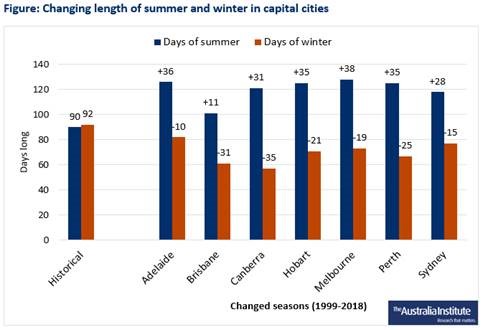Australian Summer Now Over One Month Longer
New research from the Australia Institute Climate & Energy Program shows that the Australian Summer is getting longer and Winter is getting shorter, due to global warming.
The Australia Institute analysis uses Bureau of Meteorology (BoM) data to track changes in daily temperatures that mark the beginning of each season over the sub-tropical and temperate parts of the country where most Australians live.
Key findings:
- In the two decades 1999-2018, compared to the mid-twentieth century benchmark:
- Summer temperatures were experienced for a full 31 days longer than the benchmark, and
- Winter temperatures were experienced for 23 days (over three weeks) less than the benchmark.
- In most recent years (2014-18) the trend has continued, leading to Australians experiencing Summers that were twice as long as Winters.
- All Australian capital cities experienced longer Summers and shorter Winters (figure below.)
- Some regional areas of Australia such as Port Macquarie NSW, are experiencing even more dramatic changes to the length of seasons, and are now seeing seven more weeks of traditional Summer temperatures compared to the 1950s and 60s.

“Temperatures which were considered a regular three month Summer in the 1950s, now span from early to mid-November all the way to mid-March,”said Richie Merzian, Climate & Energy Program Director at the Australia Institute.
“Following the hottest Summer on record, it commonplace to hear older Australians claim Summers aren’t what they use do be. And they are right.
“Our findings are not a projection of what we may see in the future. Its happening right now. Summer have grown longer even in recent years, with the last five years facing summers twice as long as their winters.
“Place such as Port Macquarie in NSW, which suffered devasting fires early in the fire season, are now experiencing seven more weeks of Summer compared with the 1950s and 60s.
“As the length of the bushfire Summer season extends, the window to enforce bushfire management strategies, typically in Winter, shrinks.
“Global heating is already making Australian Summers a longer and more dangerous ordeal than they used to be. Extreme heat events are the most fatal of all natural hazards and have been responsible for more deaths in Australia than all other natural hazards put together.
“Extended Summers will have significant impacts on Australia’s tourism, construction and mining sectors, as well as impacting the everyday lives of Australians. When it comes to agriculture, extended Summers can damage crops and exhaust livestock.
“Australia is currently experiencing an average of 1 degree of global warming and Summers have extended by around a month. The Australian Government’s current emission reduction targets are aligned with 3 to 4 degrees of warming, which leaves young Australians facing ever lengthening Summers with significant consequences.
“According to numerous modelling exercises, including those commissioned by the federal government, it is in Australia’s national interest and economic interest to put in place a strong policy to reduce emissions. The Australian Government’s current policies only serve to further fuel the climate crisis.”
The report, Out of Season: Expanding summers and shrinking winters in subtropical and temperate Australia, by Tom Swann and Mark Ogge can be downloaded here.
Related research
General Enquiries
Emily Bird Office Manager
Media Enquiries
David Barnott-Clement Media Advisor